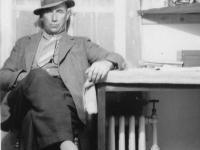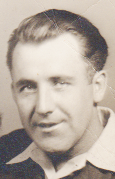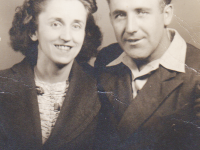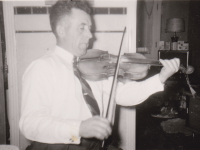 ♪ ♫ ♪ From 2005 until 2010, I was one of two hosts at a weekly bluegrass and old-time music jam session at Grumpy's Bar in Montreal. As a fiddle player, I had spent the previous six years learning the old-time fiddle music of the southern United States. In particular, I was fascinated by the music of pre-commercial and early commercial fiddlers from Kentucky, West Virginia, Virginia, and North Carolina, whose repertoires extended back well into the 19th century.
♪ ♫ ♪ From 2005 until 2010, I was one of two hosts at a weekly bluegrass and old-time music jam session at Grumpy's Bar in Montreal. As a fiddle player, I had spent the previous six years learning the old-time fiddle music of the southern United States. In particular, I was fascinated by the music of pre-commercial and early commercial fiddlers from Kentucky, West Virginia, Virginia, and North Carolina, whose repertoires extended back well into the 19th century.
Various American folklorists had made recordings of local old-time fiddlers starting around the1930s and many of these recordings had been made available through the U.S. Library of Congress, university archives, and tapes in personal collections which were often copied and sent among fiddle enthusiasts throughout the continent who were interested in discovering the older fiddle styles not represented on commercial recordings.
Unlike much of the commercially recorded fiddle music which had become more homogeneous to meet market demands after the Second World War, the music of these home-grown fiddlers generally showcased highly unique styles and repertoires that were often local to a small geographic area such as a county or a cluster of villages. After having taken several trips down to the southern United States to study their music, and having befriended a fiddler who had done extensive collecting of old-time Kentucky fiddlers during the 1970s and 1980s, I suspected that there might be similar collecting opportunities in Canada. Unlike in the United States, there didn't seem to be as large a group of Canadian fiddlers interested in discovering the obscure older fiddle tunes and styles, so I felt there were likely relatively unknown local fiddle styles and tunes in Canada still awaiting discovery.
 Click here for audio of the Drops of Brandy by Erskine Morris. (Courtesy of Brian Morris)" alt="erskine.sm__0.png" class="img-right caption" />Some time in 2008, a talented acoustic guitarist named Brian Morris began attending our weekly jam session in Montreal. He mentioned that his father, Erskine Morris, was an old-time fiddler. When I asked where his father was from, he replied, "Gaspé." Perhaps somewhat predictably for a younger Anglophone with roots outside of Quebec, I said, "so, he was French then."
Click here for audio of the Drops of Brandy by Erskine Morris. (Courtesy of Brian Morris)" alt="erskine.sm__0.png" class="img-right caption" />Some time in 2008, a talented acoustic guitarist named Brian Morris began attending our weekly jam session in Montreal. He mentioned that his father, Erskine Morris, was an old-time fiddler. When I asked where his father was from, he replied, "Gaspé." Perhaps somewhat predictably for a younger Anglophone with roots outside of Quebec, I said, "so, he was French then."
To paraphrase Brian’s answer, he told me that his father was from an Irish village called Douglastown on the Gaspé coast, and that his family was a mix of Irish and French Canadians, though just about everyone in the village was English-speaking. Intrigued, I asked Brian if he might have any home-made recordings of his father that I could listen to. He said he did but warned me that they were just home-made cassettes and weren't of the best audio quality and that I probably wouldn't be very interested in hearing them. I assured him that poor audio quality was not a deterrent as I had heard plenty of great fiddle music recorded on very primitive equipment and insisted that I would love to hear his father's music.
About a year passed before Brian emailed me the first batch of his father's tunes. I was completely unprepared for what I was about to hear. This was some of the most exhilarating and passionate fiddle music I'd ever heard and was easily of the same calibre of many of the most revered southern fiddlers I had spent several years studying. This was raw, driving music being played for a room full of step dancers at a family reunion in Douglastown in 1984. The tunes were all played over Erskine's complex foot clogging, typical of Québecois fiddlers, with the fiddle tuned in several open tunings.
 The use of open tunings on the fiddle (tuning the strings to pitches different from the standard violin/fiddle tuning of G-D-A-E), was a feature common among the older generations of North American fiddlers, but has essentially disappeared in Canada among the current generation of fiddlers. I was also struck by the ancient French Canadian character of these tunes and their English titles, like "The Queen's Reel," "Fat Molasses," and "Tommy Rooney's Jig." Although the fiddle style was heavily French Canadian, it was still quite different from anything I had heard from early Québecois fiddlers like Isidore Soucy, Joseph Allard, Jos Bouchard, or Louis Boudreault.
The use of open tunings on the fiddle (tuning the strings to pitches different from the standard violin/fiddle tuning of G-D-A-E), was a feature common among the older generations of North American fiddlers, but has essentially disappeared in Canada among the current generation of fiddlers. I was also struck by the ancient French Canadian character of these tunes and their English titles, like "The Queen's Reel," "Fat Molasses," and "Tommy Rooney's Jig." Although the fiddle style was heavily French Canadian, it was still quite different from anything I had heard from early Québecois fiddlers like Isidore Soucy, Joseph Allard, Jos Bouchard, or Louis Boudreault.
After several fruitless Google searches of these tune titles and their French translations, I began suspecting that perhaps the music I had just heard was more than just a lone Anglophone Gaspesian who had managed to pick some tunes off records of French Canadian fiddlers. Perhaps this music was instead the result of a local fiddle tradition particular to the Gaspé coast around Douglastown.
 In a series of follow-up emails and phone conversations with Brian Morris, I was made aware of a rich musical culture of fiddle playing, step dancing, and square dancing that once existed on the Gaspé coast around Douglastown where his family was from. As Brian put it, "the fiddle could pull the whole town together for a party just about any night of the week in Douglastown."
In a series of follow-up emails and phone conversations with Brian Morris, I was made aware of a rich musical culture of fiddle playing, step dancing, and square dancing that once existed on the Gaspé coast around Douglastown where his family was from. As Brian put it, "the fiddle could pull the whole town together for a party just about any night of the week in Douglastown."
Brian's father, Erskine Morris, the oldest son in a family of six girls and four boys, was born in Douglastown on November 29, 1913, to Edgar Morris and Beatrice Fortin. Erskine began playing the fiddle at thirteen. His first fiddle teacher was his mother Beatrice who did not play the fiddle but who instead could sing the old tunes note-for-note similar to the well-known Madame Bolduc, also a Gaspesian of Irish and French descent from further down the coast in Newport.
The singing of fiddle tunes, sometimes referred to as "lilting" in Cape Breton and "turlutte" in French Canada, was a skill once found in many rural communities in Ireland, Scotland and Canada. Beatrice was so skilled at singing the tunes that the first piece young Erskine learned from her was "Fat Molasses," a complex tune with highly irregular musical metre, a feature common among the older French Canadian and First Nations fiddle music. A further testament to Beatrce’s skill was that when a fiddler was unavailable for a group of dancers, they would have her sing the tunes alone while clogging her feet to provide music for a square dance or for a group of step dancers.
Erskine's main fiddle tutor was an older neighbour, Joseph Drody (affectionately known as "Mr. Joe"), born in Douglastown in 1884. Erskine would walk from his home on the main road along a path through the woods to Mr. Drody's homestead on the second range. There, Erskine was taught many of the old Douglastown tunes that had been played in the area for well over a century. Erskine looked up to Mr. Joe not just as a fiddler but as a person as well.
 Joe Drody and his family were well-loved in Douglastown for their generous spirit and their laid-back demeanour. It is said that Mr. Joe had a sweet sound on the fiddle, produced with a gentle touch on the bow, and that he would edge closer and closer to the edge of his seat as he played to clog his feet. Erskine also learned tunes from Joe's brother, Charlie Drody, who was an excellent fiddler as well, and who was actually Erskine's next-door neighbour. The Drodys are renowned even today for all the musicians the family has produced. Joe Drody passed on his music to his sons Anthony, Joseph, and Johnny, who learned the fiddle. His two daughters also picked up music, Brigid becoming a guitarist and Mary Ellen a singer and guitarist.
Joe Drody and his family were well-loved in Douglastown for their generous spirit and their laid-back demeanour. It is said that Mr. Joe had a sweet sound on the fiddle, produced with a gentle touch on the bow, and that he would edge closer and closer to the edge of his seat as he played to clog his feet. Erskine also learned tunes from Joe's brother, Charlie Drody, who was an excellent fiddler as well, and who was actually Erskine's next-door neighbour. The Drodys are renowned even today for all the musicians the family has produced. Joe Drody passed on his music to his sons Anthony, Joseph, and Johnny, who learned the fiddle. His two daughters also picked up music, Brigid becoming a guitarist and Mary Ellen a singer and guitarist.
Other well known fiddlers Erskine would have heard growing up in Douglastown were Willie Grant (his mother's uncle), James Henry Connolly, Fred Kennedy, Napoleon Rooney, Tommy Rooney, Arty Savidant from York, and Patrick and Roland White from Bois-Brulé. The fiddle was so popular in Douglastown that many houses had fiddles just for occasions when a neighbour who played happened to stop by.
 Erskine was frequently engaged to play fiddle for house parties and dances around Douglastown. Being the era before amplification and guitars were commonplace, he played on these occasions with only his feet clogging for accompaniment. These parties being rather raucous affairs, Erskine developed a self-contained style of playing that featured an aggressive bow attack, extremely precise and highly syncopated rhythms, and sharp foot clogging patterns. He would also often re-tune his fiddle to open tunings which would give his fiddle more volume and resonance. Essentially, Erskine was the “whole band” and had to create as much music as possible with his fiddle and feet to propel a room full of rowdy dancers.
Erskine was frequently engaged to play fiddle for house parties and dances around Douglastown. Being the era before amplification and guitars were commonplace, he played on these occasions with only his feet clogging for accompaniment. These parties being rather raucous affairs, Erskine developed a self-contained style of playing that featured an aggressive bow attack, extremely precise and highly syncopated rhythms, and sharp foot clogging patterns. He would also often re-tune his fiddle to open tunings which would give his fiddle more volume and resonance. Essentially, Erskine was the “whole band” and had to create as much music as possible with his fiddle and feet to propel a room full of rowdy dancers.
Like many Gaspesians, accompanied by his new bride, Kyra Grant, also from Douglastown, Erskine left the coast in search of work after the end of the Second World War. The couple moved to Powerscourt, Quebec, in the Châteauguay Valley, south of Montreal. There, he purchased a farm with the help of a veterans assistance loan, and began his family with Kyra. During his time in Powerscourt, Erskine would often play the fiddle after a day's work in the field. Just about every weekend, a gang of fellow Gaspesians would come out to the farm to hear the fiddle.
 Growing up, Brian Morris remembers his mother and father hosting parties with fellow Gaspesians most weekends. Sometimes Erskine's friends would show up unannounced at the farm from Montreal late in the evening, long after Kyra and Erskine had gone to bed. Nonetheless, the visitors were always given a warm welcome to come into the house for a night of music, step dancing, and cheer that would last until the early hours of the morning. Erskine was never reluctant to play music for friends, especially if there were step dancers among them.
Growing up, Brian Morris remembers his mother and father hosting parties with fellow Gaspesians most weekends. Sometimes Erskine's friends would show up unannounced at the farm from Montreal late in the evening, long after Kyra and Erskine had gone to bed. Nonetheless, the visitors were always given a warm welcome to come into the house for a night of music, step dancing, and cheer that would last until the early hours of the morning. Erskine was never reluctant to play music for friends, especially if there were step dancers among them.
After twelve years in Powerscourt, Erskine moved his family to Verdun, where, Brian remembers, his father often played most of the day at home on weekends. After the Second World War, you could often find many expatriate Gaspesians in Montreal neighbourhoods like Verdun, Lasalle, and Notre-Dame-De-Grâce, and so Erskine often entertained friends around Montreal with his music until he retired in Cambridge, Ontario, in the late 1970s.
 As well as playing fiddle for the Gaspesian diaspora around Montreal, Erskine made numerous home recordings of his fiddle playing which he and his wife would copy and mail out to friends and relatives from the Gaspé across the country who missed hearing the old Gaspesian fiddle music. When these tapes reached their destination, the recipient would usually make copies for several family members and friends and so even today, there are many Gaspesian households throughout Canada that have copies of Erskine Morris' home recordings. Erskine's home-recording legacy spans four decades, extending from the late 1950s until the early 1990s. These recordings, made on reel-to-reel and cassette recorders, include music Erskine made at house parties, family reunions, or alone in his living room. Erskine would also take his recorder when visiting his Gaspesian musician friends, back home and abroad, and would record them. In this way, Erskine also left us with many recordings of his family and neigbours playing fiddle, harmonica, guitar, mandolin, tenor banjo, lilting tunes, and singing songs.
As well as playing fiddle for the Gaspesian diaspora around Montreal, Erskine made numerous home recordings of his fiddle playing which he and his wife would copy and mail out to friends and relatives from the Gaspé across the country who missed hearing the old Gaspesian fiddle music. When these tapes reached their destination, the recipient would usually make copies for several family members and friends and so even today, there are many Gaspesian households throughout Canada that have copies of Erskine Morris' home recordings. Erskine's home-recording legacy spans four decades, extending from the late 1950s until the early 1990s. These recordings, made on reel-to-reel and cassette recorders, include music Erskine made at house parties, family reunions, or alone in his living room. Erskine would also take his recorder when visiting his Gaspesian musician friends, back home and abroad, and would record them. In this way, Erskine also left us with many recordings of his family and neigbours playing fiddle, harmonica, guitar, mandolin, tenor banjo, lilting tunes, and singing songs.
 During Erskine's time away from the coast, he was exposed to the music of commercially recorded French-Canadian, Down East, Ontario, Cape Breton, and Métis fiddlers, and in this way learned many new tunes from outside of the Gaspesian tradition. What is perhaps unique about Erskine as an old-time fiddler is that he would always adapt the new music he was learning into his native fiddle style. This would often require that the melody and rhythms of the tunes be significantly reworked. However, as Brian tells me, Erskine was very assured that playing the tunes in the Gaspé style was the best way they could be played. Also, unlike many old-time fiddlers who began learning tunes from commercial records, Erskine never abandoned the local Gaspé tunes he learned growing up. For this reason, we often find Erskine playing popular Don Messer and Andy DeJarlis tunes alongside the old Gaspé favourites, with the new and old repertoires all rendered into Erskine's Gaspé style.
During Erskine's time away from the coast, he was exposed to the music of commercially recorded French-Canadian, Down East, Ontario, Cape Breton, and Métis fiddlers, and in this way learned many new tunes from outside of the Gaspesian tradition. What is perhaps unique about Erskine as an old-time fiddler is that he would always adapt the new music he was learning into his native fiddle style. This would often require that the melody and rhythms of the tunes be significantly reworked. However, as Brian tells me, Erskine was very assured that playing the tunes in the Gaspé style was the best way they could be played. Also, unlike many old-time fiddlers who began learning tunes from commercial records, Erskine never abandoned the local Gaspé tunes he learned growing up. For this reason, we often find Erskine playing popular Don Messer and Andy DeJarlis tunes alongside the old Gaspé favourites, with the new and old repertoires all rendered into Erskine's Gaspé style.
With all the music and information Brian was providing me about his father and the old Gaspesians he remembered, I thought there might be some interest in this music among fiddle aficionados on the Internet. I thought the same fiddlers I had met and corresponded with while I had been studying the old-time southern fiddle music might be interested in these old Gaspé tunes. Around December 2009, I began to entertain the idea of creating an Internet “blog” (http://gaspefiddle.blogspot.com) to serve as a place where Brian and I could share his father's tunes and information on the Gaspesians who played this music.
By March 2010, Brian and I had posted several of his father's tunes on our new blog, and it became clear that a significant portion of those interested in our work were Gaspesians, many of whom now lived throughout Canada and the United States. As I became aware of the scope of the Gaspesian diaspora and how fragile their culture had become over the past sixty years, I realized that our blog could be a useful resource for current and future generations of Gaspesians and their descendants who might benefit from a free online resource where they could explore their musical heritage. In order to better understand the forces that shaped Gaspesian fiddle music, I decided that I would benefit from meeting Gaspesians now living around Montreal who had first-hand contact with this music.
Click here for That Gaspé Sound: Exploring the Old-Time Fiddle Traditions of the Gaspé Coast, Part 2
This clip is from a kitchen party at Phyllis Morris' place in Douglastown in the summer of 2011 Featured here are the Drodys, Brian Morris, Laura Risk, and the author. (Courtesy of Laura Risk)
*Glenn Patterson is a Montreal-based old-time fiddle player. He plays fiddle and old-time banjo with several Montreal area groups and is interested in local North American fiddle traditions. He is the co-founder of http://gaspefiddle.blogspot.com , a website devoted o documenting the older fiddle traditions of the Gaspé coast.
